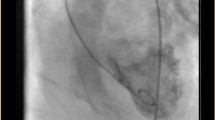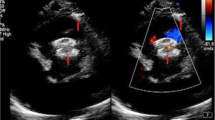Abstract
Using an Amplatzer membranous eccentric occluder, 186 patients with an average weight of 43.5 kg (range 12.5–77) underwent attempted catheter closure of a perimembranous venricular septal defect (PMVSD). Their age ranged from 3 to 51 years, with the an average age being 15.9 years. The patients were divided into three groups according to morphology of PMVSD: 106 patients with single PMVSD, 63 patients with single PMVSD with aneurysmatic formation, and 17 patients with multiple VSD with aneurysmatic formation. Using angiography, PMVSDs were measured to be between 2.5 and 12 mm, with an average of 5.1 mm. In the third group of patients, we did not measure the size of PMVSD and a device was selected according to the size of entry to the aneurysm. The device was successfully implanted in all patients. The immediate closure rate was 90% in the first group, increasing to 100% at 1 month and remained at that level during follow-up. The immediate closure rate in the second group was 98% and remained the same during follow-up. The immediate closure rate in the third group was 89% and during 1 year of follow-up remained the same. There was no clinical evidence of hemolysis and no incidence of device embolization or bacterial endocarditis after implantation.
Before the procedure, all patients showed normal electrocardiogram (ECG) or left ventricle enlargement. After the procedure (at least 3 months later) ECG showed left anterior hemiblock (LAH) in nine patients, complete right bundle branch block in eight patients, and incomplete right bundle branch block in seven patients. A complete heart block (CHB) developed in 2 patients after the procedure (1.07%). The first patient developed LAH immediately after closure and CHB within 24 hours, The heart rate was 28 beats per minute. After treatment with steroids and atropine, CHB changed to sinus rhythm with LAH within 2 months. One year later, the ECG revealed the same findings. The second patient developed CHB immediately after the procedure and was on temporary pacing for 1 week. After 1 month, the patient recovered to sinus rhythm and ECG showed LAH.

Similar content being viewed by others
References
R Arora V Trehan A Kumar et al. (2003) ArticleTitleTrancatheter closure of congenital ventricular septal defects experience with various devices J Cardiol 16 83–91 Occurrence Handle10.1159/000070120
CL Backer RC Winters VR Zales et al. (1993) ArticleTitleRestrictive ventricular septal defect: how small is too small to close? Ann Thorac Surg 56 1014–1018 Occurrence Handle10.1016/0003-4975(95)90006-3 Occurrence Handle8239793
JL Bass GS Karla R Arora (2003) ArticleTitleInitial human experience with the Amplatzer perimembranous ventricular septal occluder device Cathet Cardiovasc Interv 58 238–245 Occurrence Handle10.1002/ccd.10406
X Gu YM Han JL Titus et al. (2000) ArticleTitleTranscatheter closure of membranous ventricular septal defects with a new Nitinol prosthesis in a natural swine model Cathet Cardiovasc Interv 50 502–509 Occurrence Handle10.1002/1522-726X(200008)50:4<502::AID-CCD29>3.0.CO;2-8
ZM Hijazy (2003) ArticleTitleCatheter closure of atrial septal and ventricular septal defects using the Amplatzer devices Heart Lung Circ 12 S63–S72 Occurrence Handle10.1046/j.1443-9506.2003.t01-3-.x
ZM Hijazi F Hakim AA Haweleh et al. (2002) ArticleTitleCatheter closure of perimembranous ventricular septal defects using the new Amplatzer membranous VSD occluder: Initial clinical experience Cathet Cardiovasc Interv 56 508–515 Occurrence Handle10.1002/ccd.10292
SL Hill CI Berul HT Patel et al. (2000) ArticleTitleEarly ECG abnormalities associated with transcatheter closure of atrial septal defects using the Amplatzer septal occluder J Interv Card Electrophysiol 4 469 Occurrence Handle10.1023/A:1009852312907 Occurrence Handle11046184
CA Pedra SR Pedra CA Esteves et al. (2004) ArticleTitlePercutaneous closure of perimembranous ventricular septal defects with the Amplatzer device: technical and morphological considerations Cathet Cardiovasc Interv 61 403–410 Occurrence Handle10.1002/ccd.10797
ML Rigby AN Redington (1994) ArticleTitlePrimary transcatheter umbrella closure of perimembranous ventricular septal defects Br Heart J 72 368–371 Occurrence Handle7833197
AM Rudolph (2001) Ventricular septal defect AM Rudolph (Eds) Congenital Diseases of the heart: Clinical–Physiological Considerations EditionNumber2 Futura Armonk, NY 197–244
EB Sideris KP Walsh JL Haddad et al. (1997) ArticleTitleOcclusion of congenital ventricular septal defetcs by the buttoned device Heart 77 276–279 Occurrence Handle9093050
BD Thanopoulos GS Tsaousis E Karanasios NG Eleftherakis C Papp (2003) ArticleTitleTranscatheter closure of perimembranous ventricular septal defects with the Amplatzer asymmetric ventricular septal defect occluder: preliminary experience in children Heart 89 918–922 Occurrence Handle10.1136/heart.89.8.918 Occurrence Handle12860872
M Vogel ML Rigby D Shore (1996) ArticleTitlePerforation of the right aortic valve cusp: complication of ventricular septal defect closure with a modified Rashkind umbrella Pediatr Cardiol 17 416–418 Occurrence Handle10.1007/s002469900093 Occurrence Handle8781098
Author information
Authors and Affiliations
Corresponding author
Rights and permissions
About this article
Cite this article
Masura, J., Gao, W., Gavora, P. et al. Percutaneous Closure of Perimembranous Ventricular Septal Defects with the Eccentric Amplatzer Device: Multicenter Follow-up Study. Pediatr Cardiol 26, 216–219 (2005). https://doi.org/10.1007/s00246-005-1003-7
Published:
Issue Date:
DOI: https://doi.org/10.1007/s00246-005-1003-7




